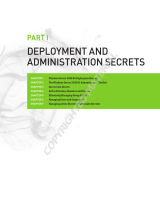
1 Overview..................................................................................................................................... 5
iSCSI deployment.................................................................................................................................................................. 5
Supported hardware and software..................................................................................................................................... 5
Preinstalled roles and services configurations on your system....................................................................................... 5
2 Configuring your NAS system........................................................................................................7
Initial configuration of your NAS system.............................................................................................................................7
Server Manager roles, role services, and features............................................................................................................ 7
Starting and exiting Server Manager............................................................................................................................ 8
Installing or uninstalling Server Manager roles, role services, and features................................................................... 8
Accessing administrative tools for your NAS systems......................................................................................................8
Accessing computer management......................................................................................................................................8
Work folders........................................................................................................................................................................... 9
Installing work folders......................................................................................................................................................9
Creating sync share for work folders.......................................................................................................................... 10
Creating a new DFS namespace........................................................................................................................................ 10
Creating new DFS replication group..................................................................................................................................10
Adding DFS namespaces to display................................................................................................................................... 10
Adding replication groups to display................................................................................................................................... 11
File Server Resource Manager ...........................................................................................................................................11
Multipath I/O.........................................................................................................................................................................11
Adding devices on MPIO................................................................................................................................................11
3 Managing your NAS system......................................................................................................... 13
Dell EMC OpenManage Server Administrator..................................................................................................................13
Remote Desktop for Administration.................................................................................................................................. 13
Activating remote desktop connection....................................................................................................................... 14
Creating and saving remote desktop connection.......................................................................................................14
Reinstalling NAS operating system using a DVD..............................................................................................................14
Recovering an OS partition...........................................................................................................................................15
Deploying the OS using Dell Lifecycle Controller....................................................................................................... 16
Dell EMC Rapid Appliance Self Recovery......................................................................................................................... 16
Creating RASR USB recovery drive.............................................................................................................................17
Recovering the Operating System using RASR USB Recovery Drive.....................................................................17
4 Using your NAS system............................................................................................................... 19
Creating server message block share................................................................................................................................19
Modifying message block shares....................................................................................................................................... 19
NFS share..............................................................................................................................................................................19
Windows domain controller as identity mapping source................................................................................................ 20
User name mapping server as identity mapping source.................................................................................................20
AD LDS as identity mapping source...................................................................................................................................21
Configuring AD LDS for services for NFS.........................................................................................................................21
Installing AD LDS server role...............................................................................................................................................21
Contents
Contents 3




















